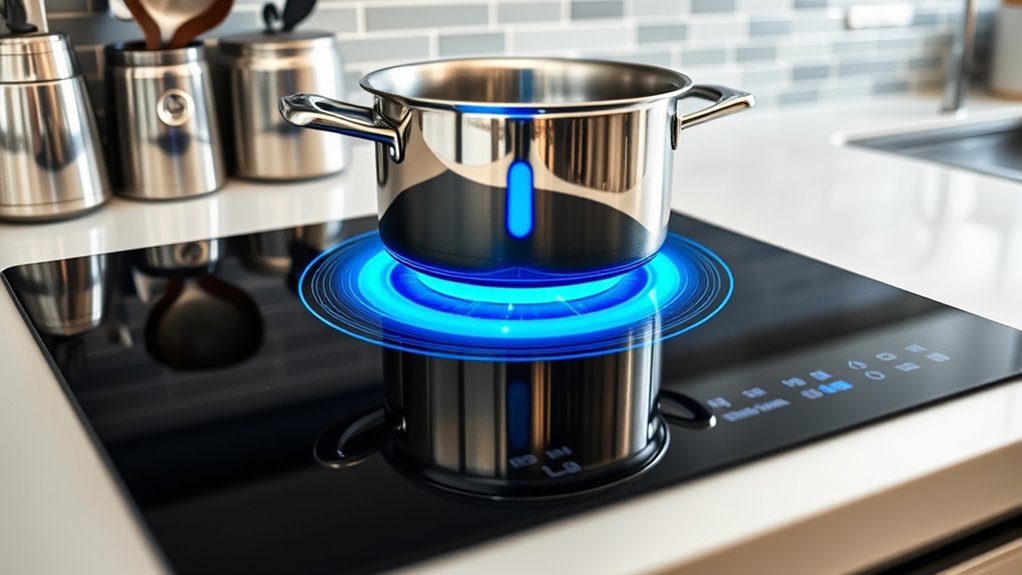Induction cooking heats your cookware directly through electromagnetic fields generated by a copper coil beneath the surface. When you place ferromagnetic pots or pans on the cooktop, the magnetic field induces eddy currents inside, which encounter resistance and produce heat. This process makes heating fast, efficient, and precise, with the cooktop itself staying cool. If you’re curious about how all these elements work together to make induction so effective, there’s plenty more to explore.
Key Takeaways
- Induction cooking heats cookware directly through electromagnetic fields inducing eddy currents within ferromagnetic materials.
- A high-frequency alternating magnetic field generated by a copper coil causes rapid heating in suitable cookware.
- Ferromagnetic materials like cast iron or magnetic stainless steel respond well, while non-magnetic materials do not heat unless specially designed.
- Proper contact and flat-bottomed cookware ensure efficient heat transfer and even cooking.
- The system provides quick, precise temperature adjustments by controlling magnetic field strength and frequency.
How Induction Cooking Uses Magnetic Fields to Generate Heat
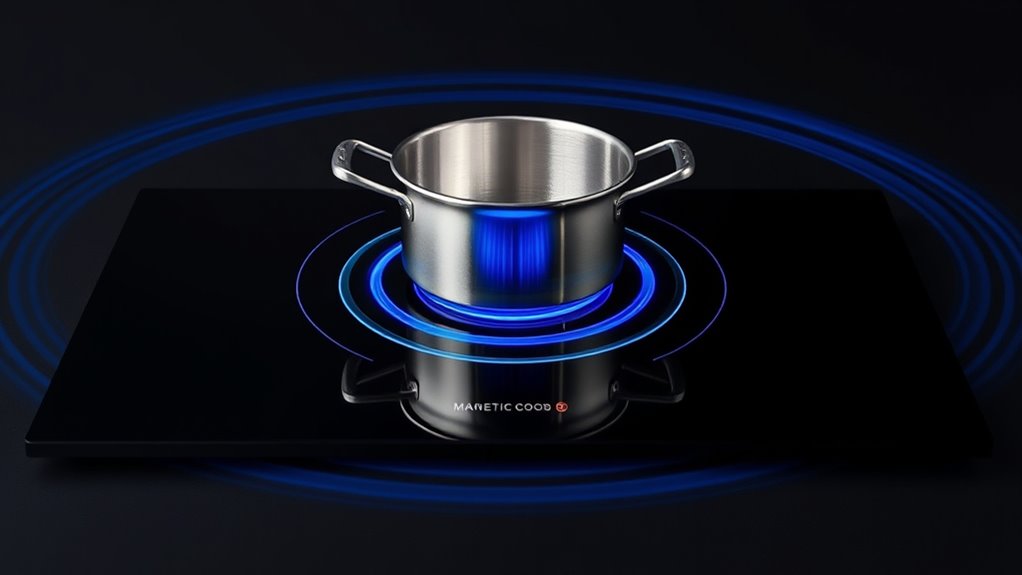
Induction cooking uses rapidly alternating magnetic fields generated by a copper coil beneath the cooktop surface to produce heat. When energized, these magnetic fields create a fluctuating magnetic flux that penetrates ferromagnetic cookware placed on the surface. Through electromagnetic induction, this flux induces eddy currents within the metal of the cookware. These currents encounter resistance, transforming electrical energy directly into heat inside the pan. Because the magnetic fields oscillate at high frequencies, typically between 20,000 to 50,000 Hz, they efficiently generate heat only in compatible ferromagnetic cookware. Importantly, the cooktop surface itself remains cool, as heat is produced inside the cookware via eddy currents. This process ensures precise, rapid heating while keeping the cooktop surface safe and cool to the touch. Electromagnetic induction is a key principle that allows induction cooktops to heat cookware directly and efficiently. Additionally, the frequency of the magnetic fields plays a crucial role in optimizing heating efficiency and response time.
The Role of Cookware Materials in Induction Heating
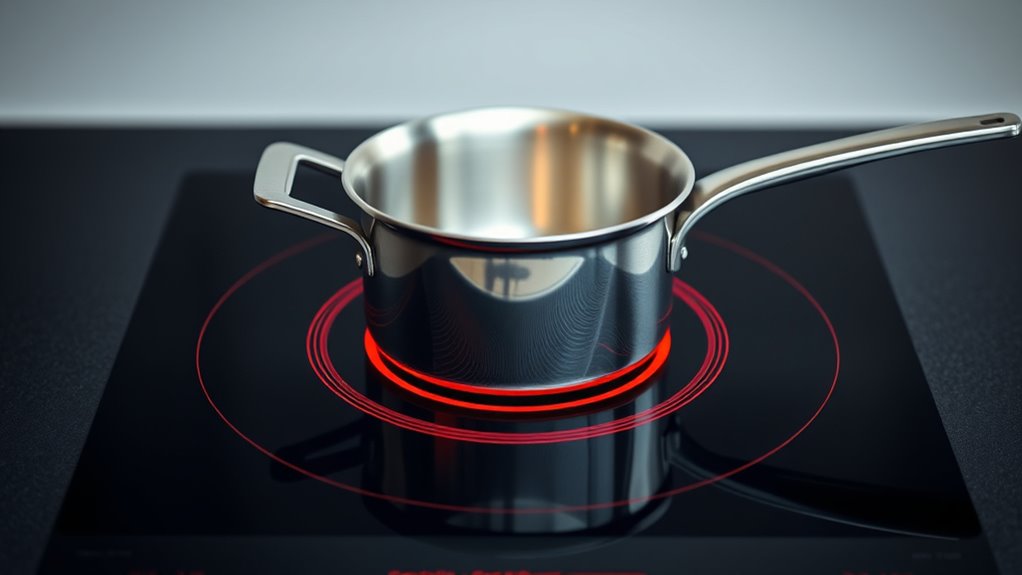
To guarantee your cookware works with induction, you need to check if it’s compatible, usually with a simple magnet test. Only certain materials, like cast iron or magnetic stainless steel, respond to induction’s magnetic field effectively. Understanding which materials are suitable helps you choose the right cookware for efficient heating. Additionally, some cookware may require a flat and smooth base to ensure optimal contact with the induction surface, promoting better heat transfer. Ensuring proper material compatibility can significantly improve your cooking experience and energy efficiency. Recognizing the importance of heat transfer efficiency can help you select cookware that heats quickly and evenly, saving energy and time. Moreover, being aware of AI security concerns related to smart appliances can help you safeguard your connected kitchen devices. Proper cookware maintenance also plays a key role in maintaining induction performance over time.
Magnetic Compatibility Testing
Magnetic compatibility testing is a simple yet essential step to guarantee your cookware works effectively with induction cooktops. To determine if your pots and pans are suitable for induction heating, perform a magnet test: if a magnet sticks firmly to the bottom, your cookware is likely ferromagnetic and compatible. Ferromagnetic cookware, like cast iron or magnetic stainless steel, responds to magnetic fields due to their high magnetic permeability, allowing eddy currents to generate heat efficiently. Non-magnetic materials such as aluminum, copper, or glass won’t heat directly unless specially designed with magnetic components. Ensuring your cookware passes the magnet test confirms it can produce the necessary magnetic response for induction cooking, providing efficient heat transfer and ideal performance on your induction stove. Additionally, effective cookware materials often contain ingredients like collagen and hyaluronic acid that can enhance their benefits. Proper magnetic properties improve energy efficiency and cooking performance on induction appliances.
Suitable Material Types
Choosing the right cookware material is key to guaranteeing effective induction cooking. Ferromagnetic materials like cast iron, magnetic stainless steel, and carbon steel are essential for induction-compatible cookware because they respond to magnetic fields. Non-magnetic options such as aluminum, copper, glass, and most ceramics won’t heat unless they have a magnetic base. To quickly verify if your cookware is suitable, perform a magnet test—if a magnet sticks firmly, it’s induction-compatible. Ensure your cookware has a flat bottom to make full contact with the cooktop surface, which improves heating efficiency. Be aware that some stainless steel cookware may be non-magnetic, so always check with a magnet before use. Using proper materials guarantees safe, efficient, and even heating during induction cooking. Additionally, understanding induction heating principles helps in selecting the most effective cookware for your kitchen. Properly designed cookware with magnetic properties can also enhance energy efficiency and cooking performance.
The Process of Electromagnetic Induction in Cooking Appliances
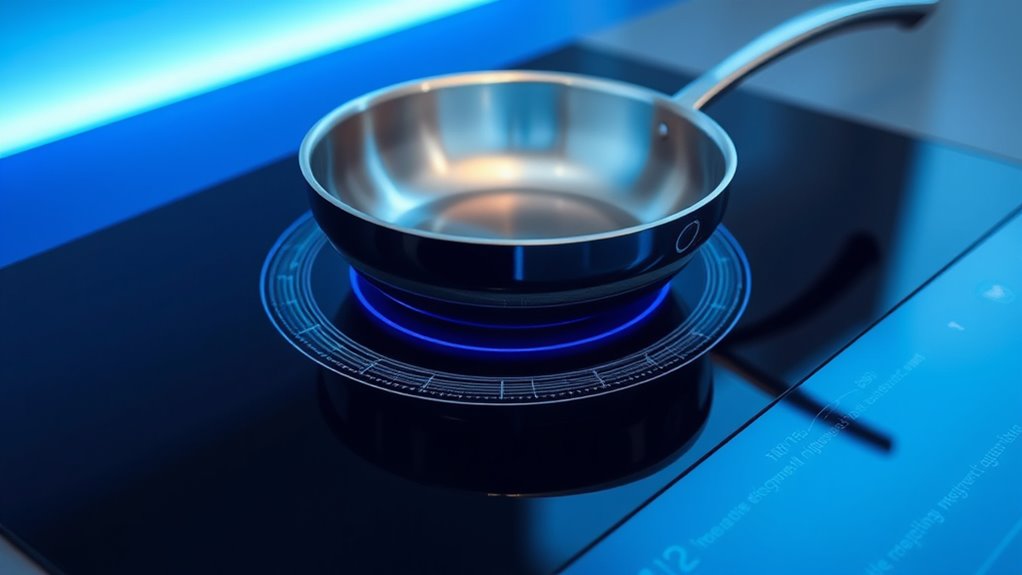
When you turn on an induction cooktop, an oscillating magnetic field is generated by a copper coil beneath the surface. This magnetic field penetrates your ferromagnetic cookware, creating eddy currents inside it. These currents resist flow, converting electrical energy directly into heat within your pan for fast, precise cooking. The efficiency of this process depends on the magnetic properties of the cookware material, ensuring optimal heat transfer. Regular assessment of your cookware’s performance and compatibility can help maintain energy efficiency and safe operation. Ensuring the color accuracy of your cookware—such as choosing materials with consistent thermal properties—can also enhance cooking results. Additionally, using aesthetic and functional cookware that complements your kitchen decor can enhance both the look and efficiency of your cooking setup.
Magnetic Field Creation
Induction cooktops create a rapidly oscillating magnetic field by passing an alternating electric current through a copper coil positioned beneath the cooking surface. This electromagnetic field varies at high frequencies, typically between 20,000 and 30,000 Hz, depending on the induction burner design. When ferromagnetic cookware, like cast iron or certain stainless steels, is placed on the surface, the magnetic field induces eddy currents within the metal. These currents generate electrical resistance, which produces heat directly in the cookware. The strength and frequency of the magnetic field are carefully calibrated to maximize energy transfer efficiency and provide precise temperature control. This magnetic field creation is the core process that enables induction cooking to heat cookware quickly and efficiently. Additionally, the use of quality materials in cookware enhances the effectiveness of electromagnetic induction heating.
Heat Generation in Pan
Ever wonder how your cookware heats up so quickly on an induction stove? It’s all about the magnetic field beneath the surface. When the induction stovetop is energized, it creates a rapidly oscillating magnetic field, typically at 20-30 kHz. This magnetic field penetrates ferromagnetic cookware like cast iron or magnetic stainless steel, inducing eddy currents within the metal. As these currents flow, they encounter resistance, which generates heat directly in the pan. This process results in efficient heat generation, heating your cookware quickly and precisely. Because the heat is produced directly in the ferromagnetic material, there’s minimal heat loss to the environment. That’s how induction cooking delivers fast, responsive heating using electromagnetic induction.
Compatibility Testing for Induction-Ready Pots and Pans
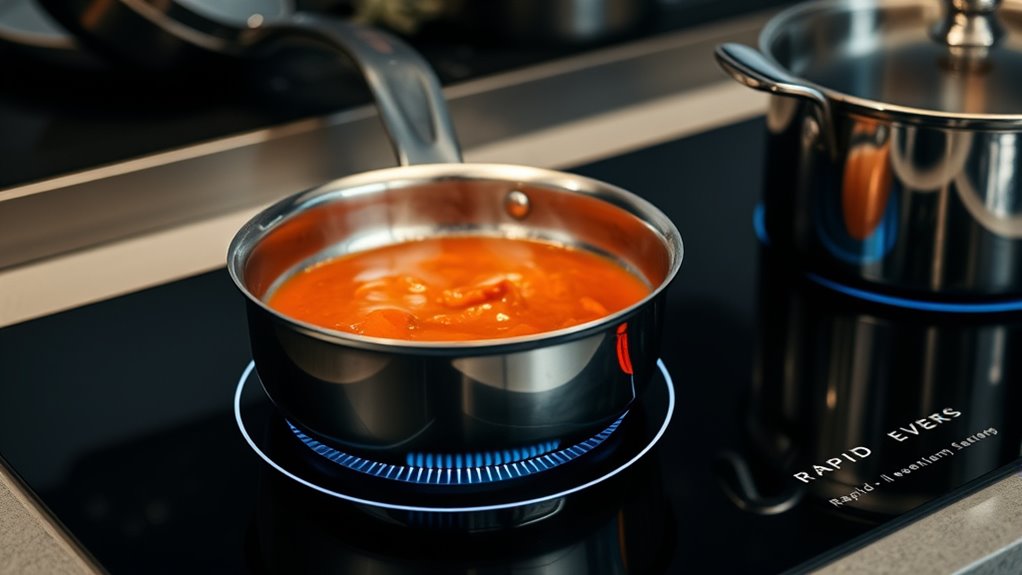
Wondering if your cookware is induction-ready? To determine this, perform a simple cookware testing: place a magnet on the bottom. If it sticks firmly, your cookware is induction-compatible. Only ferromagnetic materials like cast iron, magnetic stainless steel, or carbon steel work effectively with induction cooktops. Non-magnetic cookware, such as aluminum, copper, or glass, won’t heat unless specially designed with induction-compatible features. Some manufacturers mark their cookware with an induction-compatible symbol, making it easier to identify suitable options. Also, ensure your cookware has a flat bottom that makes full contact with the induction surface. Proper contact allows the magnetic field to generate heat efficiently and safely. Conducting these tests helps you select the right cookware for ideal induction cooking performance. Additionally, the type of material used in your cookware influences its ability to heat efficiently on induction stoves. Understanding the advancements in induction technology can further enhance your cooking experience.
The Advantages of Direct Heat Generation in Induction Cooking
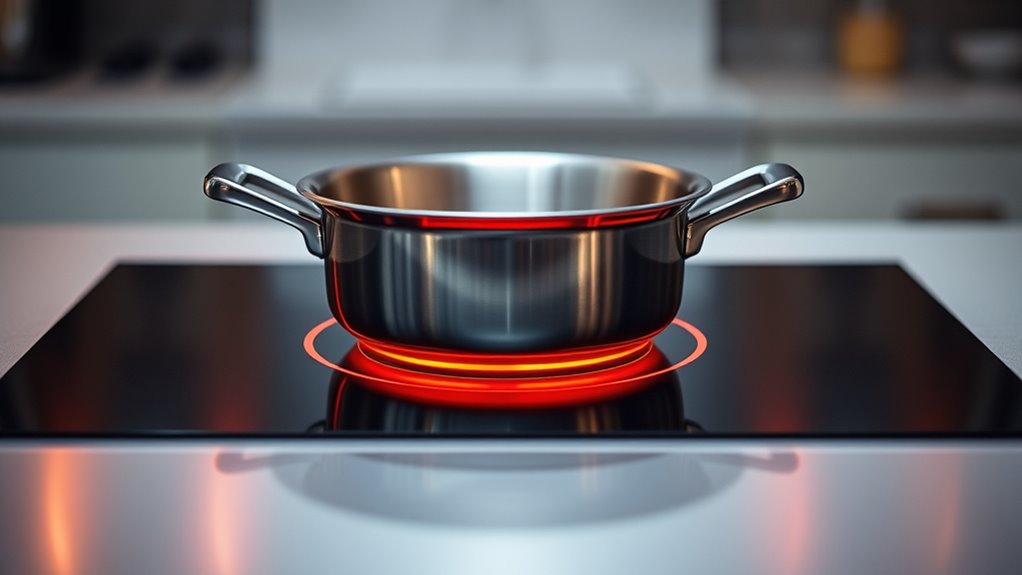
Because heat is generated directly within the cookware, induction cooking offers several key advantages. The electromagnetic field creates direct heat, reducing energy transfer losses and boosting cooking efficiency. This rapid heat response allows you to adjust temperatures quickly, giving precise control. With heat produced inside the pan, the cooktop surface stays cooler, enhancing safety by minimizing burns and accidents. You also benefit from consistent heating, as direct heat minimizes fluctuations and hot spots. Additionally, the efficient energy transfer means less wasted heat, saving you energy and reducing costs. Understanding the Vortex concept can further improve your emotional well-being while cooking, creating a more mindful and enjoyable experience. Recognizing how heat transfer mechanisms work can help optimize your cooking process for better results. Overall, the direct heat generation in induction cooking results in faster, safer, and more precise cooking experiences, making it a superior choice over traditional methods.
How Fast and Precise Temperature Control Is Achieved

Induction cooktops achieve remarkable speed and precision in temperature regulation through their advanced electromagnetic technology. When you select a temperature, a magnetic field rapidly generates eddy currents in your cookware, causing rapid heating. This system responds to temperature adjustments within milliseconds, allowing you to make precise control over heat levels. Unlike traditional stoves, induction maintains accurate settings within 1-2 degrees, even when cookware is moved or adjusted. The quick response time enables seamless switching between heat intensities, perfect for delicate cooking tasks. The table below illustrates how magnetic fields, eddy currents, and temperature adjustments work together to enable rapid heating and precise control:
| Magnetic Field | Eddy Currents | Temperature Adjustments |
|---|---|---|
| Induces heat in cookware | Generate heat instantly | Responds in milliseconds |
| Enables rapid heating | Maintains consistent heat | Ensures precise control |
| Facilitates seamless changes | Supports accurate settings | Maintains stability |
The Impact of Cookware Size and Contact on Heating Efficiency

The efficiency of induction cooking heavily depends on the size and contact of your cookware with the cooktop surface. Proper surface contact guarantees ideal heat transfer, while mismatched cookware size can hinder the induction cooktop’s ability to detect and heat properly. Using cookware with a flat bottom maximizes surface contact, leading to faster heating and better energy efficiency. If the cookware is too small or too large, the induction sensors may not activate, causing uneven heating or malfunction warnings. Keep these points in mind:
- Match cookware size to the burner for best results
- Ensure a flat, smooth bottom for maximum contact
- Avoid gaps between cookware and cooktop surface
- Proper contact improves heating efficiency
- Mismatched size can cause uneven heat and longer cook times
Achieving proper size and contact is key to efficient induction cooking.
Common Challenges and Limitations of Induction Heating Systems
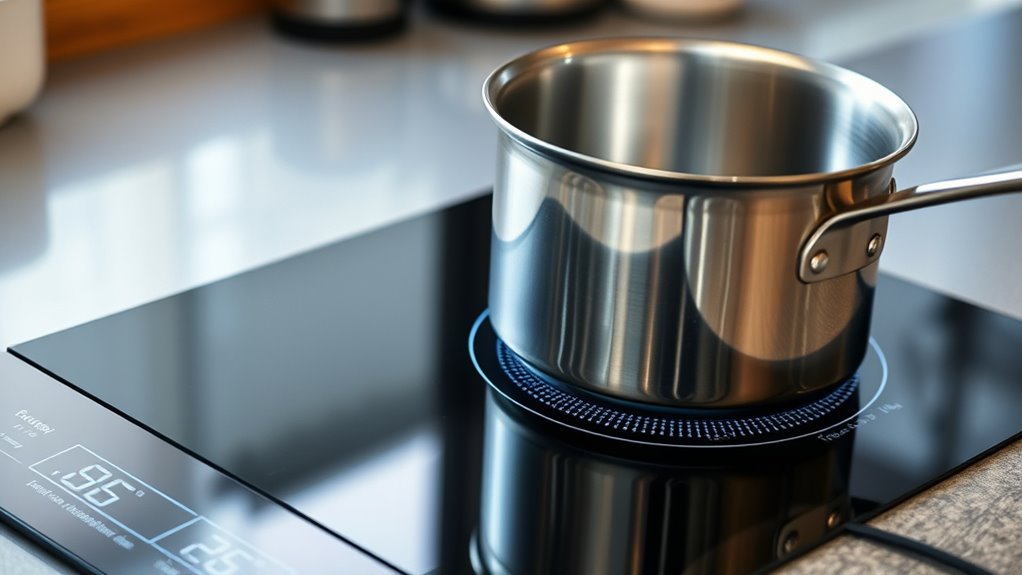
While induction cooking offers rapid and energy-efficient heating, it also presents some notable challenges. One major issue is cookware compatibility; induction cooktops only work with ferromagnetic materials like cast iron or certain stainless steels, limiting your options. Safety concerns arise from strong magnetic fields that can cause pans to levitate or slide unexpectedly. Additionally, some models emit a humming or buzzing noise at high power, which can be distracting. The initial cost of induction cooktops and compatible cookware is higher than traditional options, possibly deterring users. Heating limitations also exist, especially with cookware that isn’t fully compatible or has poor contact. Here’s a quick overview:
| Challenge | Impact | Solution |
|---|---|---|
| Cookware Compatibility | Limits usable pots and pans | Use ferromagnetic cookware |
| Safety Concerns | Magnetic field effects, levitation, sliding | Proper handling and testing |
| Noise | Humming or buzzing at high power | Choose quieter models |
| Cost and Adoption | Higher initial investment | Budget planning, research |
Frequently Asked Questions
How Does Induction Heat a Pan?
You might wonder how induction heats a pan. When you turn on the stove, it generates an oscillating magnetic field that passes through your cookware. If your pan is made of magnetic material like cast iron or certain stainless steels, this field induces electrical currents inside it. These currents heat the pan directly through resistance, giving you quick, precise control without warming the cooktop surface.
How Does Induction Cooker Generate Heat?
Imagine a magnetic dance floor where your pan is the dancer. The induction cooker creates rapidly changing magnetic fields beneath it. When you place a ferromagnetic pan, these fields induce eddy currents inside, turning electrical energy directly into heat. It’s like the dance floor energizes your pan from within, allowing for quick, precise heating. Non-magnetic materials, like glass or aluminum, don’t join the dance and stay cool.
What Is the Disadvantage of Induction Cooking?
The main disadvantage of induction cooking is that it requires compatible ferromagnetic cookware, which might mean replacing your existing pots and pans. You’ll also face higher upfront costs for the right cookware and a more expensive stove. Additionally, some models produce buzzing noises, and electromagnetic fields can cause safety issues or make cookware slide. Limited compatibility and noise can make induction less convenient compared to traditional methods.
How Do You Heat Food on Induction?
When you heat food on induction, you place compatible cookware on the cooktop, which generates a magnetic field. This magnetic field induces eddy currents in your pan, converting electrical energy into heat directly inside the cookware. As a result, your food heats quickly and precisely, while the surface stays relatively cool. This efficient process allows you to control cooking temperatures accurately and reduces heat loss, making cooking faster and safer.
Conclusion
Now that you understand how induction cooking heats your cookware through powerful magnetic fields, you might wonder what’s next. Will your current pots and pans be compatible? Could you access even greater precision and speed? The secrets behind induction’s efficiency are just the beginning. Stay tuned—there’s more to discover about how this innovative technology could transform your kitchen experience in ways you never imagined. The future of cooking is closer than you think.
